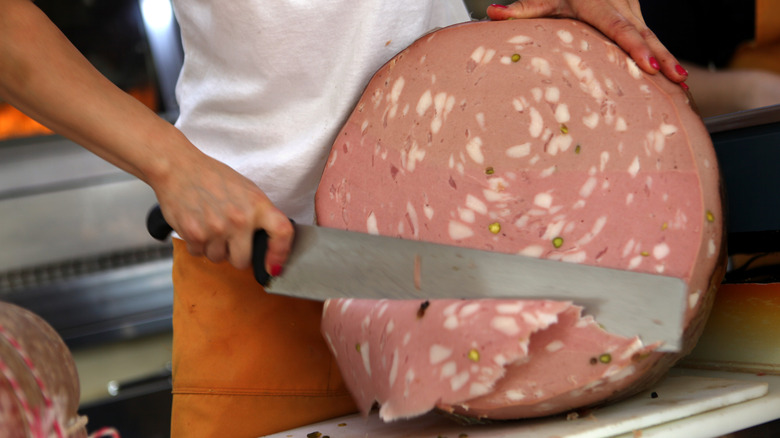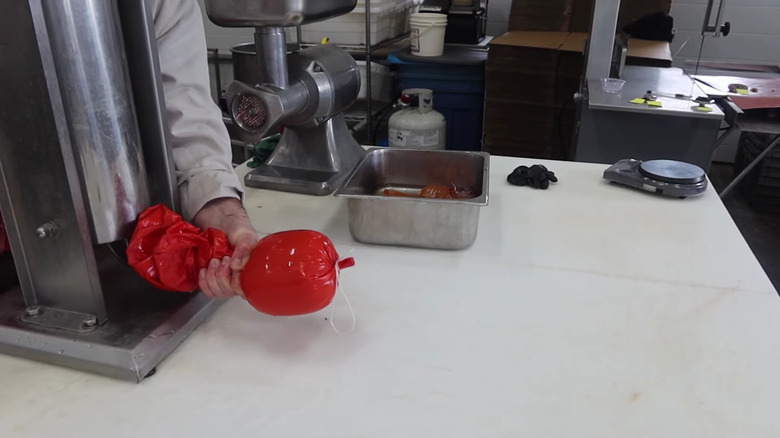Here's What Bologna Actually Is (And Other Facts That Might Surprise You)
Generations of Americans spent their childhood tucking into bologna sandwiches. In the school cafeteria, the home kitchen, and everywhere else, this simple meal of white bread and smooth, pink meat reigned supreme.
Like most cafeteria foods, however, bologna receives a less-than-stellar response from adults. So widespread is this dismissal of the meat that it is even part of the United States' lexicon, as explained to Eater by professor of food studies Amy Bentley: "It's been inserted into the national psyche of despicable foods, laughable foods. 'That's baloney, that's crazy.' That's how we think of it. It's been embedded in our brains that way."
Despite being widely mocked, bologna remains a desirable food product in some people's eyes. In 2017, Americans purchased 236.4 million pounds of bologna from grocery stores. This number is all the more impressive given that a poll commissioned by the National Hot Dog and Sausage Council found that only 35% of American consumers know what bologna actually is. Given this shockingly low percentage, we thought it best to clarify a few things about one of America's most pervasive sandwich meats, starting with what it actually is.
Bologna is a type of sausage made from finely ground meat and spices
Bologna is a type of sausage with roots in the Italian city of the same name. Like most food products, the sausage is defined by its texture and flavor. The texture arises due to the sausage's production process, in which meat is finely ground alongside other ingredients, resulting in a paste-like consistency. Traditionally, the grinding was done by hand with a mortar and pestle. Today, machines break down meat in a rapid and uniform manner.
Most bologna is heavily spiced with the likes of coriander, nutmeg, and pepper. Yet, the sausage's most prominent flavor notes — bitter, spicy, and with a hint of citrus – come from the inclusion of myrtle berries. These berries are native to the Mediterranean and have been used to flavor sausages for millennia.
The spiced, ground filling is mixed with water, sweetener, and extra fat before being encased and cured. Sometimes, bologna is also smoked. In other cases, liquid smoke is added. The intensity of this smoky flavor varies from producer to producer.
It is derived from mortadella
Bologna is a close derivative of another Italian sausage from the city of Bologna, mortadella. Unlike bologna, which is a relatively new culinary invention, mortadella has been produced in Italy for thousands of years.
All the ingredients that make up mortadella are not ground together, as they are in bologna. Instead, chunks of fat, pistachios, and other flavorings stud the sausage. The unique appearance and excellent taste that results from this approach have seen mortadella become increasingly popular globally, especially in the U.S. This was celebrated by chef Evan Funke in an interview with The Los Angeles Times: "Mortadella is the moment, always has been. I think it's one of the most underrated salumi to come out of anywhere in the world; it's underutilized, underappreciated, super versatile, and I think it's the best, so I love that it's getting a little bit of traction."
Mortadella's growing popularity puts it at odds with the oft-ridiculed bologna. The former's more authentic Italian origins undoubtedly play a part in its global success. Yet, the lack of history or cultural significance that surrounds bologna is also one of its strengths, as it allows producers and chefs the freedom to experiment that other heritage products — mortadella included — do not.
American bologna is shaped by USDA guidelines
The most striking difference between mortadella and bologna is in their appearance. When cut, mortadella reveals a mosaic of ingredients, flavors, and textures. Bologna, on the other hand, is a pink, homogenous blend. Given mortadella's popularity, many may wonder why bologna producers do not adopt the rustic, ingredient-studded approach. The reason is simple: The U.S. Department of Agriculture does not allow it.
The USDA categorizes bologna as a frankfurter. As such, all bologna producers in the U.S. are subject to the same production requirements as frankfurter producers. One requirement specified by USDA is that all ingredients are reduced to minute particles, hence the paste-like texture of bologna.
Another way American bologna differs from mortadella is the hodgepodge of meat that can be used to make it. Many leading American brands, including Oscar Mayer, use a blend of chicken, pork, and beef to make bologna, as all are deemed acceptable by USDA. Traditional mortadella, on the other hand, is only made from pork.
Bologna produced in countries outside the U.S., like Mexico, often uses a higher proportion of pork, lending the products a distinct flavor. The demand for this pork-heavy bologna results in vast quantities of Mexican bologna being smuggled across the border every year.
Bologna and hot dogs are practically the same
Since the USDA classifies bologna as a frankfurter, that means it also falls into the same category as hot dogs, thus producers of the two sausages face the same requirements when making their products. For example, the USDA stipulates that both bologna and hot dogs cannot be made up of more than 30% fat.
Being made to the same requirements means that bologna and hot dogs are effectively one and the same. In an interview with Fox News, National Hot Dog & Sausage Council President Eric Mittenthal reiterated this point saying, "Bologna is essentially a very large hot dog that is sliced into slices [...] there's a lot of different styles of bologna, but one of the styles is a large hot dog that's sliced into slices."
As Mittenthal highlights, there are many varieties of both bologna and hot dogs each with its own unique flavor and ingredients. What's more, these sausages also come in a variety of sizes. Despite this, the two products are so closely linked as to be practically the same thing.
It doesn't always contain organs or raw skeletal muscle
In the U.S., bologna has a reputation as mystery meat. This means that consumers do not always know what type or cut of meat has been used to make the product. Many fear bologna contains substantial quantities of offal (organs) in place of the more expensive skeletal muscle. This fear is hard to alleviate, given that bologna's appearance gives consumers no indication of its contents.
According to the National Hot Dog and Sausage Council, the fear surrounding bologna's contents is misplaced: organs (or variety meats, as they are sometimes called) are not widely used in modern-day bologna. Even when they are, producers are bound by law to clearly list them in the ingredients. What's more, a product marketed as "bologna with variety meats" must consist of at least 15% skeletal muscle.
Upon inspection, the ingredient lists of many bologna products reveal that they have been made with mechanically separated chicken. This is residual meat that is forced from the bones when passed under pressure through a sieve. While a safe, affordable, and waste-reducing process, some high-end bologna producers prefer to use higher quality cuts, though these are also ground into a paste at a later stage.
Sausages similar to bologna were made in ancient Rome
Mortadella, the first iteration of bologna, has been enjoyed in Italy for centuries. Ancient Roman depictions of sausage making, stored in Bologna's Archaeological Museum, show people using a mortar and pestle to make sausages. They highlight that finely ground sausages, similar to modern-day bologna, were being made at this time. There are even reports that sausages of this style were used to feed the Roman army.
Mortadella was by no means the only sausage eaten in ancient Rome. Hailing from southern Italy, the Lucanica sausage — a mixture of pork, pine nuts, herbs, and spices — became a firm favorite of ancient Romans. Versions of it are still eaten in Italy today.
The survival of both Mortadella and Lucancia was not always guaranteed. In the 4th century, A.D., Emperor Constantinus converted to Christianity. As part of his conversion, he banned sausages due to their link with pagan festivities. Fortunately, production of these sausages continued, ensuring that the fantastic recipes were never lost.
Immigrants introduced bologna to America
As with many facets of the modern American diet, bologna was brought to the country by immigrants. Although it can not be definitively stated, most agree that German immigrants, and not Italians, were responsible for introducing bologna to the U.S.
This hypothesis is reinforced by places like Pennsylvania, where a large proportion of German immigrants settled in the mid-18th century. Many of these areas have a long history of bologna making, as these immigrants often opened their own butcher shops. Here, they recreated the Italian mortadella they had grown up eating in Europe. It is suggested that the prevalence of wild turkey in Pennsylvania led to this meat, and eventually others, being added alongside or in place of pork. Thus, the American bologna we know today was invented.
The sausage only spread across the rest of the country once The Great Depression took hold. As an incredibly cheap sausage, many families turned to it as a major source of protein. Even cheaper versions, that included a great deal of offal, were popularized around this time.
Oscar Mayer popularized bologna in the U.S.
In 1873, a 14-year-old German boy named Oscar Mayer immigrated to the U.S. Eventually, Mayer and his brothers opened a butcher shop in Chicago. This was the beginning of Oscar Mayer, a company that would become synonymous with bologna.
Although Mayer died in 1955, Oscar Mayer went from strength to strength. A great deal of this success came thanks to a brilliant piece of marketing, the company's famous song, which was released in 1963. In a video posted to YouTube, former marketing VP Jerry Ringlien said: "It really was the commercial that took that company to national fame and national distribution. But as time went by, it turned out we were selling as much bologna as we were hot dogs."
The attention brought on by the jingle coincided with Oscar Mayer vastly improving its products through innovations with vacuum packing. This allowed Oscar Mayer's meat products, including bologna, to last a lot longer than those products cut and wrapped in delis. Oscar Mayer further cemented its place as America's most prominent supplier of bologna when another hit jingle, this one focused on bologna, was released in 1973.
There are many types of bologna
While most Americans may only be familiar with the standard grocery store bologna, there are numerous types of bologna made in the country. Many of these are regional specialties not often found outside certain states.
In Pennsylvania, one of the most prominent types of bologna is ring bologna. This sausage is packed into a narrow, semi-circular casing which results in it carrying a more intense flavor of smoke. Commonly sliced up and eaten by itself, ring bologna has more in common with European dried salamis than it does the flaccid, store-bought discs of bologna found elsewhere in the U.S.
Another iteration of bologna native to Pennsylvania is Lebanon bologna. Traditionally, this type of bologna is made from beef, mixed with sugar and several warm-tasting spices. The sausages are then fermented and smoked. The end result is a complex, addictive sausage that can prove divisive. This was highlighted to Taste by chef Matt Russell: "It's salty; it's smoked; it's a little bit fermented. It is what it is. Some people don't like it for sure, but I think it's too good on its own to kind of mess with."
Finally, there is rag bologna, a variant hailing from west Tennessee. This sausage has a higher fat content when compared to other types of bologna, as well as more fillers. It was traditionally served wrapped in cloth, hence the name.
Yale, Michigan hosts an annual bologna festival
Although many people now shun bologna, there are plenty of Americans that continue to celebrate the sausage's existence. Approximately 20,000 of these individuals flock to Yale, Michigan every year for the town's annual bologna festival.
First held in 1989, the festival includes a variety of activities lasting over a long weekend. These include the Yale Bologna Run, the Big Bologna Parade, and tours of the local bologna plant. Speaking about the festival to MLive, Festival Coordinator Cheryl Wadsworth said: "There is no gimmick, it is 100-percent beef. It's just a way to celebrate the tradition of what our town was built on."
Of course, there are many opportunities to enjoy the sausage itself. C. Roy Processing reportedly donates two tons of its bologna to the festival every year. Ask any local and they will tell you the best way to sample it is by eating one of the festival's trademark fried bologna sandwiches.
Bologna sandwiches are often served in prisons
Over recent decades, bologna has become a prison food staple in America. Usually, bologna is given to inmates in the form of sandwiches. In the mid-2000s, the Dakota County Jail, in Minnesota, made headlines when it began serving two turkey bologna sandwiches to inmates for their dinner every day of the year. There were also numerous reports of rotten bologna sandwiches being served to inmates in Orange County, California during the Coronavirus pandemic.
The prison system's reliance on bologna sandwiches boils down to money. Swapping out hot food for these sandwiches saves prisons a great deal. This was highlighted to the Arkansas Democrat-Gazette in 2013 by Andy Shock, who was Faulkner County Sheriff at the time: "We realized we could save a lot of money just by taking away one hot meal a day [and two on weekends] and still meet the state requirements of calories. We completely shut the kitchen down to any cooking on Saturday and Sunday ... If it was up to me, we'd serve [sandwiches] three meals a day, seven days a week, 365 days."
Even when served in good condition, the constant diet of bologna sandwiches leaves inmates unsatiated. The diet has also been seen to negatively impact inmates' health, leading to higher blood pressure due to the sausage's fat and sodium content.
David Chang is a fan of bologna
David Chang, American culinary legend and host of the hit TV program "Ugly Delicious," has championed many foods over the years. In 2014, he turned his gaze on bologna and decried its lack of popularity to GQ. To Chang's mind, bologna has all the trappings of mortadella, without cultural constraints. He even included bologna on the menu of his restaurant Momofuku Ssäm Bar.
Chang has also claimed that there is a dearth of artisanal-made bologna in the U.S. But, as we have seen, regional varieties of bologna are still lovingly made in the U.S. — particularly in Pennsylvania. For example, Seltzer's Smokehouse Meats have been making 100% beef Lebanon bologna since 1902. The sweet version was described by one reviewer on Amazon as follows: "This is the most delectable sweet Lebanon bologna you'll ever taste! Even made it here in the heat of summer, intact! LOVE IT. My family enjoys the slices individually spread with soft cream cheese, and rolled up–YUM! It's a real treat!"
Elsewhere, S. Clyde Weaver, from Lancaster County, produces a range of artisanal bolognas including an outstanding, smoked ring bologna. Old Fashioned Sweet Bologna and Garlic Ring Bologna are two further options made by this respected producer.
Bologna sandwiches can be found in restaurants across the country
Perhaps following Momofuku's lead, many restaurants across the U.S. are now serving bologna sandwiches. One of the most popular of these is found at Au Cheval, a gastropub in Chicago. Chef Jeremy Fisher described his take on the dish to Bon Appétit: "Crisping up the bologna takes the sandwich to a new level. We like to create different textural elements: the little crispy bits of the meat combined with the parts that puff up, mixed with the gooey cheese, the creamy dijonnaise and the crisp toasted bread. I'd receive death threats if I took it off the menu."
The historic Rockford General Store in Rockford, North Carolina also sells a version of the bologna sandwich. This one is served on potato bread, and includes bologna slices that are half an inch thick. The sandwich is completed with condiments including hoop cheese, mayonnaise, and mustard. Chili or slaw rounds out the monstrous meal.













